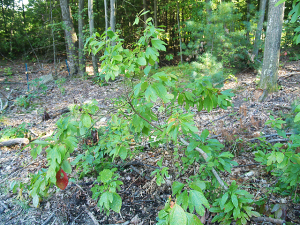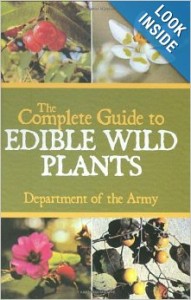I took a stroll in the woods with my dogs today and was excited to find some sassafras trees!
They are unusual trees because they have three distinct leaf patterns on the same plant, unlobed oval, bilobed (mitten-shaped), and trilobed (three-pronged). They can have five-lobed leaves, too, but that is very rare.
Edible Parts of Sassafras
According to the books I’ve checked, Sassafras leaves, roots (root bark) and twigs are all edible. The roots and twigs are used to make tea and iced beverages, and were used in the flavoring of traditional root beer. The leaves are used as a seasoning in food.
The FDA prohibited the use of sassafras oil and safrole in commercially mass-produced foods and drugs in 1960. This was based on animal studies in which Safrole, an oil produced by the sassafras trees, was determined to be a cancer causing agent. Many people dispute whether this concern is warranted given the fact that no human has ever gotten sick from drinking sassafras tea. A small amount of safrole is consumed when drinking the tea, compared with the massive doses given to the rodents in the studies.
Gumbo Filé!
It’s pretty late in the season and a few of the leaves are starting to turn color, but I’m hoping to harvest enough leaves tomorrow to make some Filé powder. Filé powder, a spicy herb made from the dried and ground leaves of the sassafras tree, is also called gumbo filé because it is used in making gumbo, and Jambalya, Creole and Cajun stews.
About a year ago I tried to find Filé powder in several markets and specialty stores in Rhode Island with no luck, so I’m very excited to have the opportunity to make my own.
Recipes that use Sassafras
It looks like I’ll have to buy some fresh okra for that Filé Gumbo recipe. I’ve seen fresh okra at Gopu Grocery, a local Indian market where I like to shop at 295 Daniel Webster Highway in Nashua.
Music
While you’re cooking your Gumbo or Jambalya you can can click on the link below to listen to Hank Williams Sr. sing Jambalaya on the Bayou. I’ve included the lyrics so you can sing along!
Jambalaya on the Bayou
Goodbye Joe me gotta go me oh my oh
Me gotta go pole the pirogue down the bayou
My Yvonne the sweetest one me oh my oh
Son of a gun we’ll have big fun on the bayou
Jambalaya and a crawfish pie and file gumbo
Cause tonight I’m gonna see my ma cher amio
Pick guitar fill fruit jar and be gay-o
Son of a gun we’ll have big fun on the bayou
[ fiddle ]
Thibodaux Fontaineaux the place is buzzin’
Kinfolk come to see Yvonne by the dozen
Dress in style and go hog wild me oh my oh
Son of a gun we’ll have big fun on the bayou
Settle down far from town get me a pirogue
And I’ll catch all the fish in the bayou
Jambalaya and a crawfish pie…
[ fiddle ]
Later on, swap my mon, get me a pirogue
and I’ll catch all the fish on the bayou
Swap my mon, to buy Yvonne what she need-oh
Son of a gun we’ll have big fun on the bayou
Jambalaya and a crawfish pie…
I found helpful information on sassafras and other wild plants in the books featured below.
Backyard Foraging: 65 Familiar Plants You Didn’t Know You Could Eat
I found this book to be very helpful! The photographs are good and the information is thorough and well presented. This book is ideal for someone new to foraging like myself. There’s no need to put on your hiking boots because the edible weeds, flowers, mushrooms, and ornamental plants featured in the book are typically found in urban or suburban neighborhoods. You can just wander out into your backyard and find gourmet produce!
This is a wonderful reference book to add to your personal library!
Far from complete as claimed in the title, this book describes habitat and distribution, physical characteristics, and edible parts of many wild plants but not in great detail. The photos are poor quality, and I wouldn’t feel comfortable trying to identify plants using them. The book covers the tropics, subtropics, and temperate zones. Since I’m not planning a visit to the tropics or subtropics I wasn’t interested in many of the plants covered. I caught several typos and that made me worry about the accuracy of other information in the book. Sadly, the term “good enough for government work” comes to mind to describe this book. The back cover says that the book was originally created for use by U.S. Army personnel. I sure hope our troops have a better handbook than this one to help them survive in the wild. I would not recommend purchasing this book.





